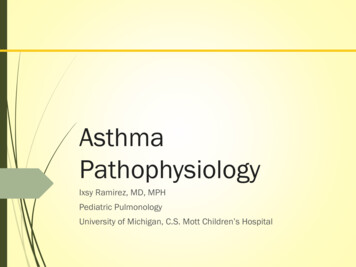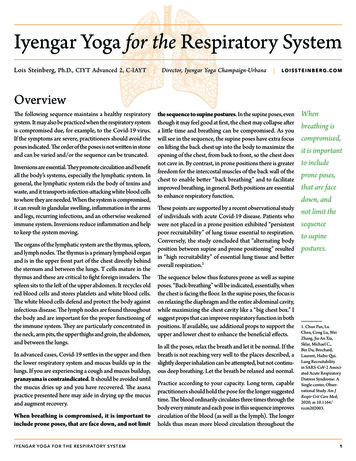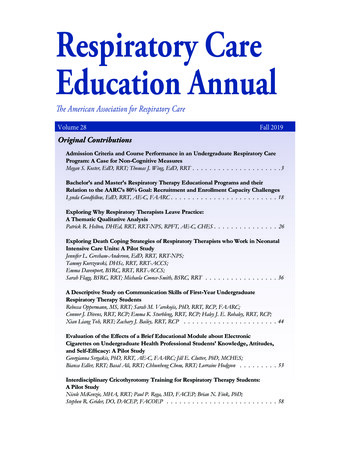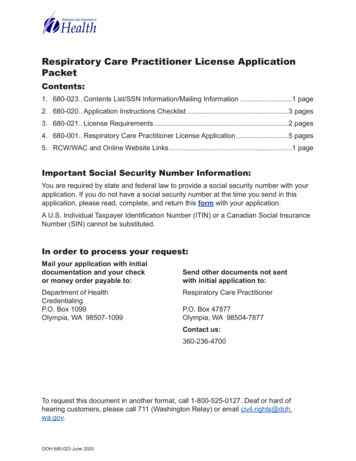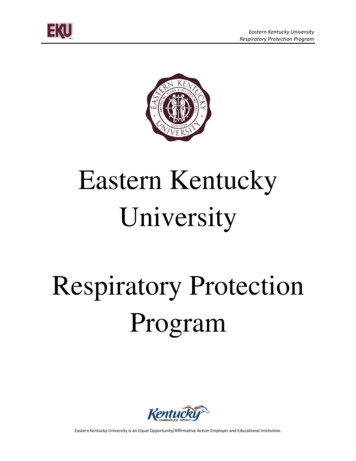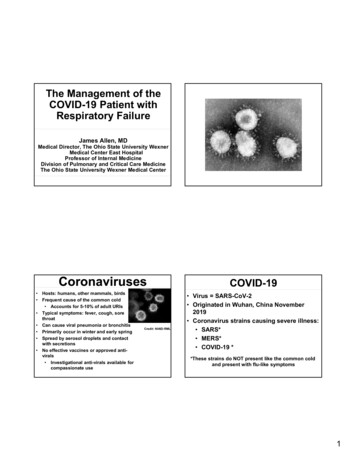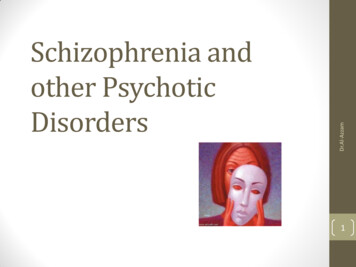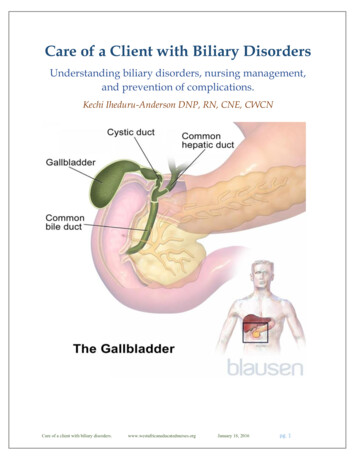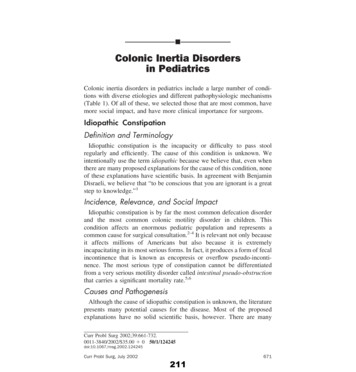
Transcription
Respiratory Lecture, pg 1 of 12Pediatric Respiratory Disorders, Bridget Parsh, RN, CNS, EdDSee book for asthma and child CPRRespiratory Assessment LOC Vital Signs (RR, HR,temp) Color.can get dusky pretty quick. Inspection (chest expansion, WOB). The chest wall is very soft and can see WOB very easily. Auscultation Pulse oximeter Transcutaneous CO2 monitoring.can use on kids 2 to check CO2 levels through the skin.Chest RetractsXiphoid RetractsNasal flaringGruntingNoneNoneNoneNoneJust visibleJust visibleMinimalSteth onlyMarkedMarkedMarkedNaked earVideo RF Inadequate elimination of CO2 and or inadequate oxygenation of blood. Can result form lung or airwaydisease or inadequate effort (head injury) RD compensated clinical state of respiratory dysfunctin where pt has a increased rate and effort in breathing. Increased AP diameter seen in chronic lung disease Listen to lung sounds along midaxillary line and move gradually towardback.should hear soft tubular sound as air enters and minimal to nosound as air leaves. Stridor inspiratory high-pitched sound heard with airway obstruction (ofupper airway) Prolonged expiration usually with wheezing signifies obstruction of midairway? Grunting is produced by premature closure of glottis during activeexpiration.usually a sign of a pt attempting to maintain volume of gas inlungs by increasing end expiratory pressure. Pulmonary edema, PNA,atelectasis, ARDS Inspiratory retractions indicted upper airway obstruction or any diseasethat affects compliance. Children are diaphragmatic breathers until about 7 years Infant has 20 million alveoli at age.at 8 years, will have 300 million(adult level). Infants have increased metabolic demand.and oxygen consumption(6-8 ml/kg/min vs adults at 3-4 ml/kg/min) Factors making infants more susceptible to respiratory distress size of airway pliability of ribs & sternum position of ribs r/t sternum fewer alveoli high rate of oxygen consumption
Respiratory Lecture, pg 2 of 12Respiratory Distress vs. Failure Irritable vs. Lethargic Vital signs Pink vs. Pale vs. CyanoticVital sign red flags.be concerned if you see these numbers! RR 60 in infant to school-age RR 40 in adolescent HR 180 in infant, toddler preschooler (crying infant may havehigh HR.don’t freak out, you have to take things like that intoaccount) HR 160 in school-age child HR 140 in adolescentRespiratory Distress Late signs skin color changes apnea/irregular respirations (child is too tired to keepbreathing.a reason to intubate!) change in LOC bradycardiaAdventitious sounds (links on WebCT to listen to sounds) Stridor Crackles (rales).fluid Rhonchi.exudate Wheeze Albuterol is a short-acting bronchodilator that is used for wheezing. If an asthma pt is really really tight there isno air exchange and you won’t hear asthma. You give Albuterol and they get more wheezy b/c there is nowsome air exchange. Mom might think the med made it worse b/c they now hear wheezing.they are actuallyimproving.Respiratory Distress vs. Failure Respiratory distress:Increased work of breathing Respiratory failure: Inadequate oxygenation or ventilation Most common pathway to cardiac arrestPeds vs Adult Airway Narrowest point is at chricoid ring.
Respiratory Lecture, pg 3 of 12NCLEXA 2 yr old child is found on the floor next to his toy chest. After first determining unresponsiveness and calling forhelp, which of the following steps should be taken next?A: Start mouth to mouthB: Begin chest compressionsC: Check for a pulseD: Open the airwayPulse Ox Probe Placement Measures saturation of hgb.thewaveform is good when it’s pickup upthe pulse (easier when child is holdingstill) Will still pick this up if the hbg issaturated with something else such ascarbon monoxide (will say 100%-ish) This only tells you how “full the busesare”.not how many buses you have(bus RBC)Developmental Differences Smaller airway size (trachea little finger diameter) Small amount swelling large increase in resistanceH1N1 In children, emergency warning signs that need urgent medical attention include: Fast breathing or trouble breathing Bluish or gray skin color Not drinking enough fluids Severe or persistent vomiting Not waking up or not interacting Being so irritable that the child does not want to be held Flu-like symptoms improve but then return with fever and worse cough (CDC,2009)Oxygen Delivery Humidified!! What the child tolerates! Methods of Delivery Blow-by (held near the baby’s face.advantage is the child is not scared orclaustrophobic.can put a sticker in the bottom of the cup so child’s attention isdirected toward it) Face mask (very very rare kids will not tolerate that) Nasal Cannula.this child has little things on his cheek to keep the cannula inplace. Non/partial rebreather Blended O2/mist Possible to give too much oxygen.oxygen toxicity can cause problems! Signs are: cough stuffy nose N/V
Respiratory Lecture, pg 4 of 12Acute Respiratory Conditions Upper Respiratory Infection Otitis Media Pharyngitis Tonsillitis Croup BronchiolitisThe runny nose very common d/t colds, flu be careful of tissues and such.RSV can live for 6 hours outside the body. always gown up if child is on contact precautions.virus can live for a long time and you could carry it around.Tympanic membrane (one on right is inflamed)Otitis Media Inflammatory disorder of the middle ear Common 6 - 36 months of age Assessment: URI sx, fever, pain Enlarged lymph nodes Discharge from ear Vomiting/diarrhea May pull on ear, or hit on earTympanicmembrane can burst d/t ear infection.child may “feel better” after this happens (hurts during the bursting though)Prevention of Otitis Media Avoiding infection Avoid irritants Bottles in bedOtitis Media: Treatment Antibiotics – yes or no? A lot of MDs are not giving Abx if only a little bit red. Trying todecrease the amount of Abx being prescribed to help preventsuperbugs.Antipyretics/analgesics Patient/parent education
Respiratory Lecture, pg 5 of 12Otitis Media Tx (cont’d) Follow up Hearing loss Prevention Myringotomy with PE tubesPharyngitis (see picture to right) 4-7year olds Viral vs. bacterial Throat culture/rapid strep screen.should be doing BOTHof these testsPharyngitis: Nursing management: Antibiotics (if bacterial) Symptomatic Antipyretics Analgesics Fluids Preventing spread Hydration a concern b/c they will not want to drink.Pharyngitis: viral vs. bacterial Strep throat more likely to include more throat soreness tonsillar exudate more lymph node swelling higher fever abdominal painWhy do we treat strep throat with antibiotics? Bc we don’t want to worry about rheumatic heart disease or theglomerulonephritisTonsillitis Nursing assessment: Sore throat Fever Enlarged tonsils “kissing tonsils”.thetonsils are starting totouch.Surgical management: Criteria for Tonsillectomy (with/without Adenoidectomy): 3episodes/year X 3years Obstructive sleep apnea Nasal speech 3 years oldStrep Infection (above)Rheumatic Fever d/t strepKissing Tonsils (theyʼre about to touch or“kiss” each other.
Respiratory Lecture, pg 6 of 12NCLEXThe nurse cares for a six yo girl s/p a tonsillectomy. The nurse notices that the child is restless, agitated, andswallow frequently. Which of the following actions should the nurse take first?A: Observe the throatB: Call the physicianC: Reposition the childD: Take vital signsPost-operative nursing care Airway: Positioning, 02 sat monitoring, cool mist Monitor for bleeding: Earliest sign frequent swallowing Fluids/nutrition: Clear liquids to soft diet, no red/brown fluids; po fluid minimumPost-operative nursing care Pain management: Proactive: start with IV narcotics, then po meds, around-the-clock for at least 1st 24 hrs.the pain is constantand we give them pain meds around-the-clock so they don’t cry/scream and mess up the sutures. Complications: Bleeding Inadequate PO intake Unrelieved painLaryngotracheobronchitis (LTB) crouop Viral invasion/inflammation of laryngotracheobronchial tree Tightness in upper part of airway “Barking” cough. Child will often wake up in the middle of the night with abarking cough d/t dry air at home. Sometimes kids get outside in the moist airand the cough gets better. Most common cause: parainfluenza Swelling, increased tenacious secretionsLTB Diagnostic tests X-ray will show the soft tissue swelling CBC Differential Diagnosis Care: Airway/oxygen (and mist).parents can turn shower on for homecare.usually works pretty fast. Hydration Racemic epinephrine will help right away to reduce swelling.it doesn’tlast long, so the swelling will come back (need to be admitted.wouldn’tsend someone home after just giving an epi dose) Corticosteriods (you might see this as a tx for swelling) Rest/comfortNCLEX QuestionA 2 yo comes to the ER with inspiratory stridor and a barking cough. Which of the following actions should be aninitial intervention?A: Administer IV antibioticsB: Provide oxygen by facemask (wouldn’t give oxygen by facemask to a child.they’ll freak)C: Establish and maintain the airwayD: Ask the mother to go to the waiting room
Respiratory Lecture, pg 7 of 12Laryngotracheobronchitis (“aka” croup) Clinical manifestations: 3 months- 4 years URI symptoms High fever Seal-like, barky cough Inspiratory stridor Variable degree of respiratory distressNCLEXThe nurse is caring for a 3 yo girl in a croupette (little tent thing) for the treatment ofLTB. The nurse should dress the child in which of the following garments?A: A navy 2 piece pajama made of loosely woven wool (wool will get wet and heavy,and is itchy)B: A flowered night gown made of polyester blend (does not breathe)C: A pink rayon one piece jump suit (will not breathe)D: A yellow cotton sleeper (cotton breathes and is best)Epiglottitis 2- 6 years old Acute bacterial infection of epiglottis.gets inflamed and blocks the airway h. influenzae B (vaccine has nearly gotten rid of this disease) Diagnosis: 4 D’s Dysphonia Dysphagia Drooling DistressedNCLEX QuestionWhich of the following agents is related to acute epiglottitis?A: AllergenB: BacteriaC: VirusD: YeastEpiglottitis DO NOT PLACE ANYTHING IN THE AIRWAY!!! No tonguedepressors in the mouth! Treatment plan Airway management Antibiotic therapyInterventions Allow any position that maintains airway Emergency airway management team ready Pay close attention to child: do not leave alone, allow parents to stay Oxygen any way tolerated (usually blow-by) Avoid upsetting situations, keep lights down, noise downBronchiolitis 80% of cases d/t Respiratory Syncytial Virus (RSV) RSV gets into cell, kills it, causes a lot of swelling and mucus inthe airway Contact precautions b/c child has a LOT of mucus
Respiratory Lecture, pg 8 of 12Bronchiolitis cont’d Pandemic yearly High risk (ex-premies, young infants, congenital heart disease) High-risk kids will get Synagis before season starts (prophylactic) Exposure risks: April-Sept births, older siblings, day care, bottle fedBronchiolitis Symptoms: URI, nasal secretions Cough Increased WOB Crackles/wheezes Apnea (20%).can’t breathe past the mucusNCLEXWhich of the following interventions is the most important goal for the child with ineffective airway clearance?A: Reducing the child’s anxietyB: Maintaining a patent airwayC: Providing adequate oral fluidsD: Administering medications as orderedBronchiolitis Pathophysiology: URI – bronchioles Inflammation & necrosis of epithelium Increased mucus Variable airway obstructionBronchiolitis Diagnosis: WBC X-ray Nasal wash.put saline in the nose and try to get out some cells from the nasal wall.Bronchiolitis: Nursing Care Airway: Suction, Suction, Suction!!! Want to suction before they eat so they can breathe and eat at the same time. They take a 3cc saline pillow, squeeze one into the nose while you suction out through the other side. Repeat. Oxygenation/Ventilation Hydration/Nutrition Positioning/Rest/ComfortChronic Respiratory Conditions Asthma (signs of increasing respiratory distress in picture to right) restricted airway d/t inflammation mucus Cystic fibrosis Bronchopulmonary dysplasiaAcute Asthma: Assessment Family history: asthma, allergy Triggers: antigens, foods, infection, meds, GERD, stress, exercise,aspirin Tight cough Breath sounds:Exp. wheeze, crackles Increased WOB: prolonged expiratory phase
Respiratory Lecture, pg 9 of 12NCLEXA 12-year-old client with asthma is instructed in the use of a peak flow meter for improved home management of thedisease. In teaching the client, the nurse is guided by the knowledge that the purpose of the peak flow meter is toenable the client to:A: Detect airway obstruction prior to onset of manifestationsB: Take deep breaths every one to two hours (that’s the incentive spirometer)C: Accurately adjust the delivery rate of oxygen (asthma pts are not on oxygen at home)D: Breathe deeper when using metered dose inhalers (that’s a spacer)NCLEX QuestionWhich of the following interventions by the parents is appropriate to “allergy proof” the home?A: Cover the floors with carpetingB: Designate the basement as the play areaC: Dust and clean the house thoroughly twice a month.D: Use foam rubber pillows and synthetic blankets.Asthma (she buzzed through this slide b/c people wasted time telling their stupid stories) Increasing incidence Pathophysiology Inflammation Bronchial hyperresponsiveness BronchoconstrictionMedications used to treat asthma (ATI has good info about order of meds for patient teaching) Beta-2 agonists (opens the airway) Short-acting: Albuterol (proventil, ventolin). Take the Albuterol FIRST to open the airway before taking otherasthma meds! Systemic: Epinephrine, Terbutaline (brethine) Anticholinergics (increase effectiveness of beta-2 agonists) Ipratropi
Albuterol is a short-acting bronchodilator that is used for wheezing. If an asthma pt is really really tight there is no air exchange and you won’t hear asthma. You give Albuterol and they get more wheezy b/c there is now some air exchange. Mom might think the med made it worse b/c they now hear wheezing.they are actually improving.
